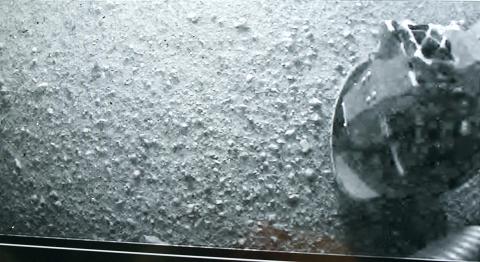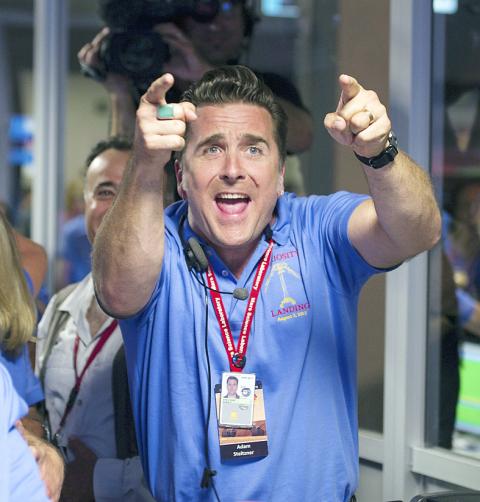In a show of technological wizardry, the robotic explorer Curiosity blazed through the pink skies of Mars, steering itself to a gentle landing inside a giant crater for the most ambitious dig yet into the red planet’s past.
A chorus of cheers and applause echoed through the NASA Jet Propulsion Laboratory (JPL) on Sunday night after the most high-tech interplanetary rover ever built signaled it had survived a harrowing plunge through the thin Mars atmosphere.
“Touchdown confirmed,” engineer Allen Chen said. “We’re safe on Mars.”

Photo: Reuters
Minutes after the landing signal reached Earth at 10:32pm, Curiosity beamed back the first black-and-white pictures from inside the crater showing its wheel and its shadow, cast by the afternoon sun.
“It looks like we landed in a nice, flat spot. Beautiful, really beautiful,” said engineer Adam Steltzner, who led the team that devised the tricky landing routine.
It was NASA’s seventh landing on Earth’s neighbor; many other attempts by the US and other countries to zip past, circle or set down on Mars have gone awry.

Photo: Reuters
The arrival was an engineering tour de force, debuting never before tried acrobatics packed into “seven minutes of terror” as Curiosity sliced through the Martian atmosphere at 21,000kph.
In a Hollywood-style finish, cables delicately lowered the rover to the ground at a snail-paced 3kph. A video camera was set to capture the most dramatic moments — which would give earthlings their first glimpse of a touchdown on another world.
Celebrations by the mission team were so joyous over the next hour that JPL director Charles Elachi had to plead for calm to hold a press conference. He compared the team to athletic teams that go to the Olympics.
“This team came back with the gold,” he said.
The extraterrestrial feat was a much-needed boost to NASA, which is debating whether it can afford another Mars landing this decade. At a budget-busting US$2.5 billion, Curiosity is the priciest gamble yet, which scientists hope will pay off with a bonanza of discoveries.
“We’re on Mars again,” NASA chief Charles Bolden said. “It’s just absolutely incredible. It doesn’t get any better than this.”
US President Barack Obama tweeted his appreciation: “I congratulate and thank all the men and women of NASA who made this remarkable accomplishment a reality.”
In a statement, Obama said the landing was “an unprecedented feat of technology that will stand as a point of national pride far into the future.”
Over the next two years, Curiosity will drive over to a mountain rising from the crater floor, poke into rocks and scoop up rust-tinted soil to see if the region ever had the right environment for microscopic organisms to thrive. It is the latest chapter in the long-running quest to find out whether primitive life arose early in the planet’s history.
The voyage to Mars took more than eight months and spanned 566 million kilometers. The trickiest part of the journey? The landing. Because Curiosity weighs nearly a tonne, engineers drummed up a new and more controlled way to set the rover down. The last Mars rovers, twins Spirit and Opportunity, were cocooned in air bags and bounced to a stop in 2004.
The plans for Curiosity called for a series of braking tricks, similar to those used by the space shuttle, and a supersonic parachute to slow it down. Next: Ditch the heat shield used for the fiery descent. And in a new twist, engineers came up with a way to lower the rover by cable from a hovering rocket-powered backpack. At touchdown, the cords cut and the rocket stage crashed a distance away.
The nuclear-powered Curiosity, the size of a small car, is packed with scientific tools, cameras and a weather station. It sports a robotic arm with a power drill, a laser that can zap distant rocks, a chemistry lab to sniff for the chemical building blocks of life and a detector to measure dangerous radiation on the surface. It also tracked radiation levels during the journey to help NASA better understand the risks astronauts could face on a future manned trip.
The landing site near Mars’ equator was picked because there are signs of past water everywhere, meeting one of the requirements for life as we know it. Inside Gale Crater is a 5km-high mountain, and images from space show the base appears rich in minerals that formed in the presence of water.
Previous trips to Mars have uncovered ice near the Martian north pole and evidence that water once flowed when the planet was wetter and toastier, unlike today’s harsh, frigid desert environment.

The Burmese junta has said that detained former leader Aung San Suu Kyi is “in good health,” a day after her son said he has received little information about the 80-year-old’s condition and fears she could die without him knowing. In an interview in Tokyo earlier this week, Kim Aris said he had not heard from his mother in years and believes she is being held incommunicado in the capital, Naypyidaw. Aung San Suu Kyi, a Nobel Peace Prize laureate, was detained after a 2021 military coup that ousted her elected civilian government and sparked a civil war. She is serving a

‘NO AMNESTY’: Tens of thousands of people joined the rally against a bill that would slash the former president’s prison term; President Lula has said he would veto the bill Tens of thousands of Brazilians on Sunday demonstrated against a bill that advanced in Congress this week that would reduce the time former president Jair Bolsonaro spends behind bars following his sentence of more than 27 years for attempting a coup. Protests took place in the capital, Brasilia, and in other major cities across the nation, including Sao Paulo, Florianopolis, Salvador and Recife. On Copacabana’s boardwalk in Rio de Janeiro, crowds composed of left-wing voters chanted “No amnesty” and “Out with Hugo Motta,” a reference to the speaker of the lower house, which approved the bill on Wednesday last week. It is

‘EAST SHIELD’: State-run Belma said it would produce up to 6 million mines to lay along Poland’s 800km eastern border, and sell excess to nations bordering Russia and Belarus Poland has decided to start producing anti-personnel mines for the first time since the Cold War, and plans to deploy them along its eastern border and might export them to Ukraine, the deputy defense minister said. Joining a broader regional shift that has seen almost all European countries bordering Russia, with the exception of Norway, announce plans to quit the global treaty banning such weapons, Poland wants to use anti-personnel mines to beef up its borders with Belarus and Russia. “We are interested in large quantities as soon as possible,” Deputy Minister of National Defense Pawel Zalewski said. The mines would be part

Cozy knits, sparkly bobbles and Santa hats were all the canine rage on Sunday, as hundreds of sausage dogs and their owners converged on central London for an annual parade and get-together. The dachshunds’ gathering in London’s Hyde Park came after a previous “Sausage Walk” planned for Halloween had to be postponed, because it had become so popular organizers needed to apply for an events licence. “It was going to be too much fun so they canceled it,” laughed Nicky Bailey, the owner of three sausage dogs: Una and her two 19-week-old puppies Ember and Finnegan, wearing matching red coats and silver